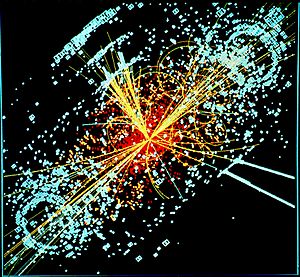Supersymmetry facts for kids
Supersymmetry is a big idea in science. It suggests that for every tiny elementary particle we know, like the ones that make up everything around us, there's a "superpartner" particle. If this is true, it would mean there are twice as many kinds of particles in the universe!
Many scientists hope to prove supersymmetry. This is because it could help explain some big mysteries in physics. It might even help us understand dark matter, which is a mysterious substance that makes up a lot of the universe but we can't see.
Supersymmetry was first thought of by a scientist named Hironari Miyazawa.
What is Supersymmetry?
This theory says that when the universe first began, tiny particles like photons (light particles), electrons (which carry electricity), and quarks (which make up protons and neutrons) were formed. At the same time, matching "superparticles" were also created.
Imagine a world where every type of building block has a twin. Supersymmetry suggests our universe might be like that. If the universe has extra dimensions (more than the three we usually think of, plus time), then there could be even more ways for these superparticles to exist.
Why is it Important?
Supersymmetry could help fill many gaps in our current understanding of how the universe works. This understanding is called the Standard Model of physics. For example, the Standard Model doesn't fully explain dark matter. Supersymmetry offers a possible explanation for what dark matter could be made of.
It would also give support to ideas like string theory. String theory suggests that all particles are tiny vibrating strings. Supersymmetry fits well with these ideas, making the universe seem more connected.
Looking for Supersymmetry
Scientists use powerful machines like the Large Hadron Collider (LHC) to look for these superparticles. The LHC smashes tiny particles together at very high speeds. They hope to see signs of superparticles being created in these collisions. However, experiments at the LHC have not found clear evidence of supersymmetry so far. Scientists continue to search and explore new ways to test this exciting idea.
See also
 In Spanish: Supersimetría para niños
In Spanish: Supersimetría para niños


